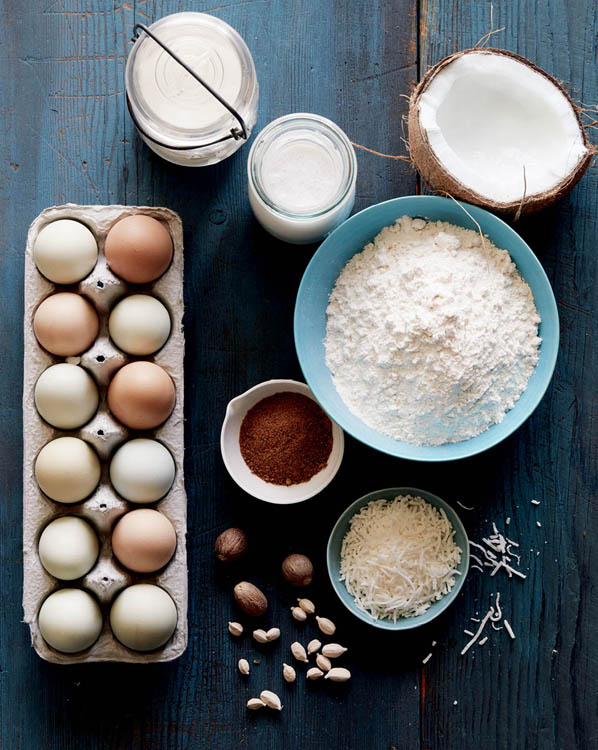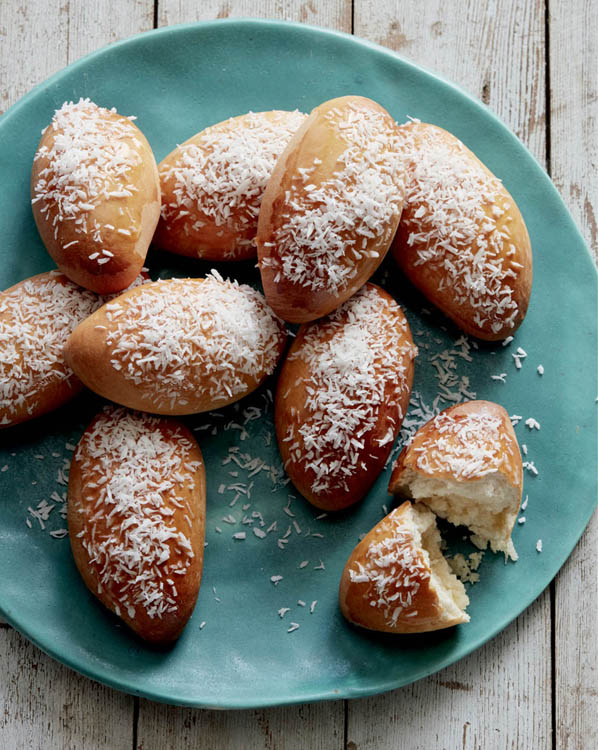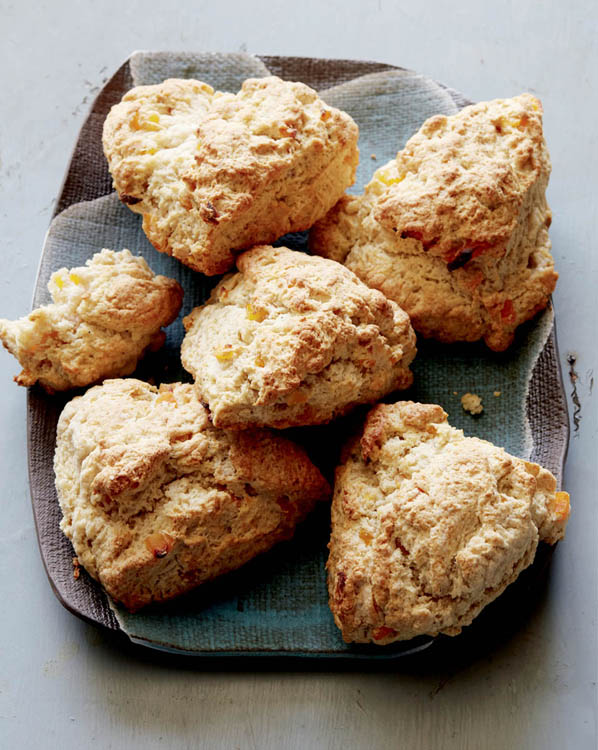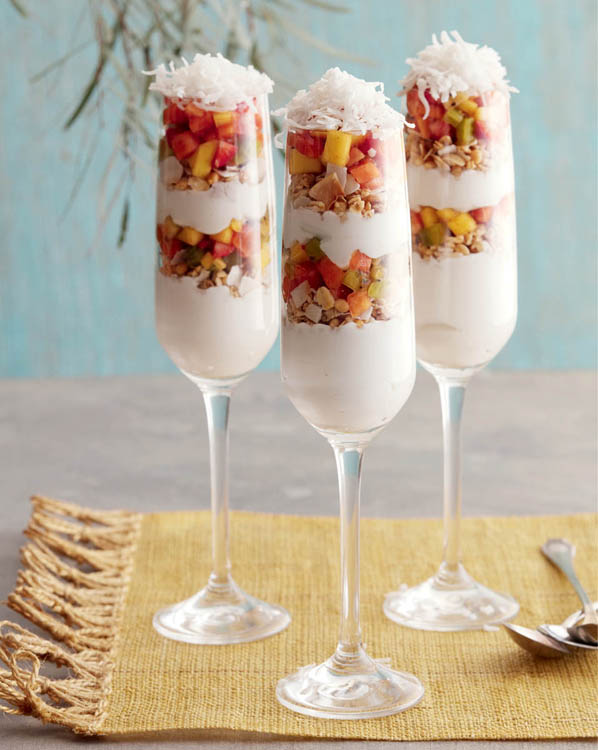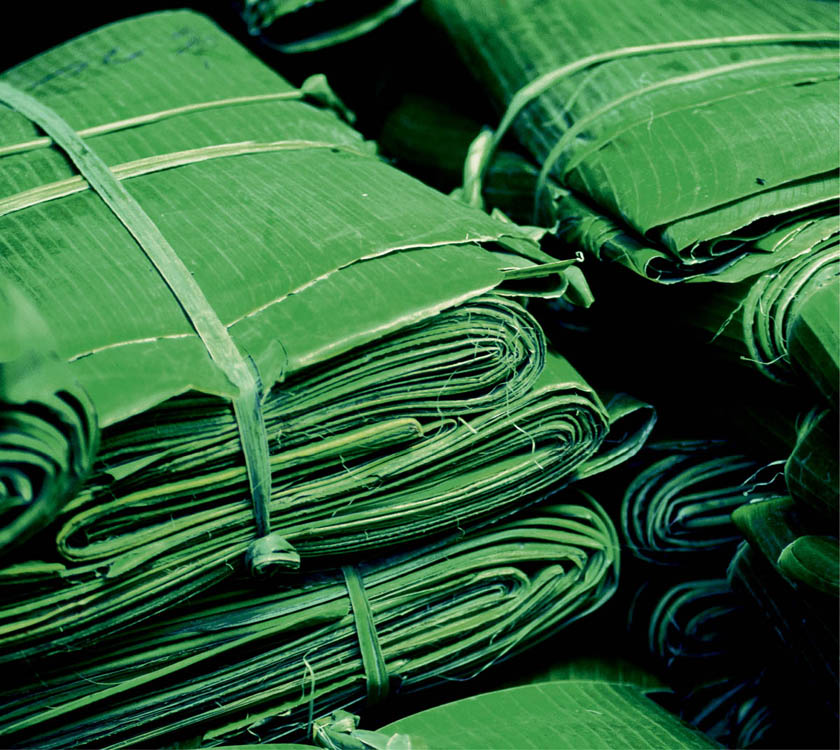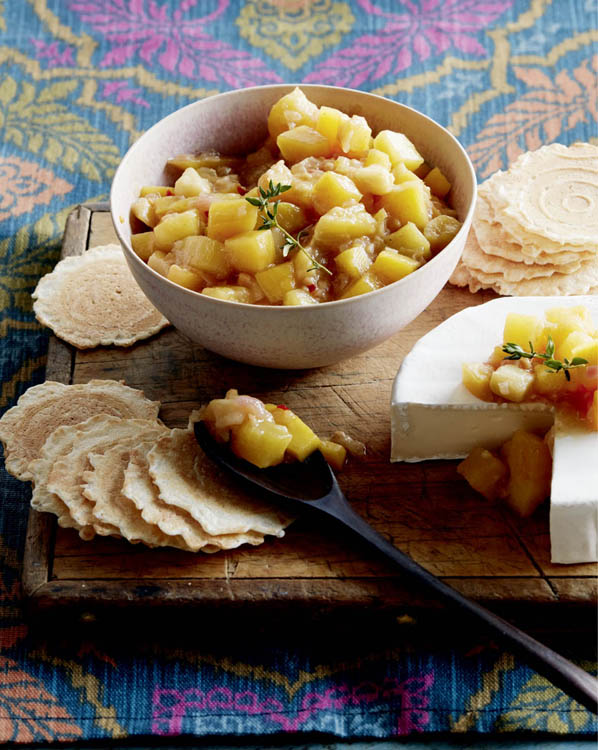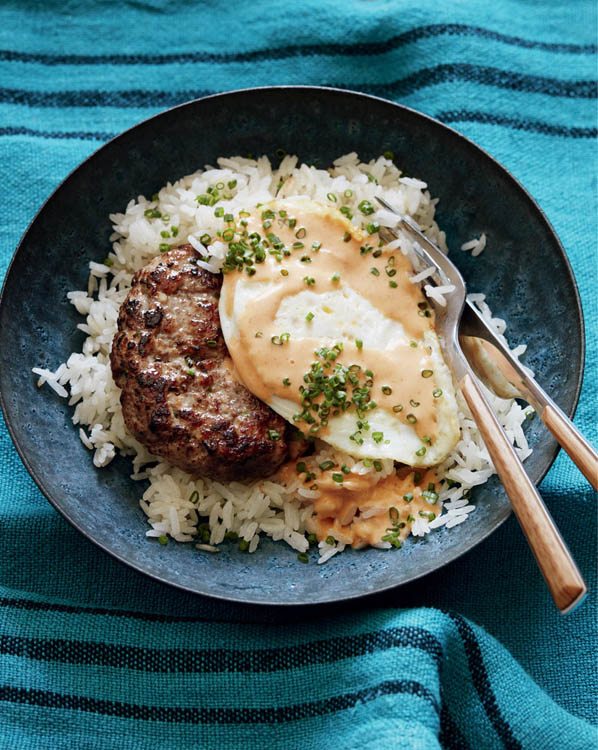5
breakfasts
To me, coconut is the ideal ingredient for breakfasts of all kinds. It can be creamy, crunchy, sweet, or savory and lends itself nicely to breakfast offerings that feature fresh, dried, or roasted fruit. This collection features my very favorite coconut breakfasts both for everyday meals and for those special occasions when you have more time to prepare. Some of the recipes, like the Coconut-Cashew-Date Breakfast Bites or the Coconut-Pineapple Granola, are also ideal snacks — perfect for making in extra batches and storing for the morning meal or whenever.
Dad’s Daily Coconut Bread
Makes 2 loaves
This recipe is so familiar to me that I can make it on autopilot. It is a basic quick bread recipe (like a carrot, pumpkin, or zucchini bread) but with coconut instead. You can substitute dried coconut for the fresh, but if you do so, increase the quantity of milk to 18 ounces. You can use regular milk in place of the evaporated, but the resulting bread will not be as tender. You’ll find mixed essence (a blend of artificial almond, orange, and pear flavorings) in Caribbean markets.
Ingredients
- 3 cups all-purpose flour
- 1 cup grated fresh or frozen coconut
- 1 cup sugar
- 1 tablespoon baking powder
- 1 teaspoon salt
- 1 (12-ounce) can evaporated milk
- 1 cup (2 sticks) unsalted butter, melted and cooled
- 1 egg
- 1 teaspoon mixed essence
- Sugar for dusting the top of the loaves (optional)
Instructions
- 1. Preheat the oven to 350°F (180°C).
- 2. Mix together the flour, coconut, sugar, baking powder, and salt in a large bowl. Set aside.
- 3. Beat together the milk, butter, egg, and mixed essence in another large bowl. Slowly add the flour mixture to the milk mixture and beat until well incorporated. The batter will be thick.
- 4. Spray two 81⁄2- by 41⁄2-inch loaf pans with cooking spray and fill each three-quarters full with batter. Bake for 40 to 50 minutes, or until the top is golden brown and a cake tester inserted into the center of the loaf comes out clean. Dust the top of the loaves with sugar, if using, and allow to cool slightly before unmolding. Serve warm or store in an airtight container for up to 4 days. Coconut bread may also be frozen for up to 1 month if well wrapped.
Note: You can also bake the batter in muffin pans. Just reduce the baking time to 25 to 30 minutes.
sunday bread
My father used to make this bread on special occasions, but in his home of Trinidad, this bread — with the addition of candied fruits or raisins — would be prepared in quantity on Sunday to be used for breakfast, afternoon tea, or a children’s snack all week. I’ve readopted that custom, baking coconut bread at least twice a week to keep on hand for my family.
Coconut Bao
Makes 20 buns
For my version of coconut bao, or gai mei bao, I adapted the savory recipe from my book Sweet Hands: Island Cooking from Trinidad and Tobago with a coconut filling. You’ll often see these buns sprinkled with sesame seeds as a garnish, but I like to paint mine with sugar syrup and then lightly dust them with superfine grated coconut instead. A warning: coconut bao are incredibly addictive. Once you’ve had these breakfast pastries, your run-of-the-mill doughnut will fail to please!
filling
- 1⁄2 cup (1 stick) unsalted butter, softened
- 1⁄2 cup sugar
- 1⁄4 cup plus 1 tablespoon nonfat dry milk powder
- 3⁄4 cup dried unsweetened shredded coconut
- 1 teaspoon vanilla extract
dough
- 21⁄4 teaspoons (1 packet) active dry yeast
- 1⁄2 cup plus 3 tablespoons plus 1⁄2 teaspoon sugar
- 1⁄2 cup warm water (110°F/45°C)
- 3 cups all-purpose flour
- 11⁄4 teaspoons baking powder
- 1 egg
- 1 egg white
- 1 tablespoon vegetable shortening melted with 1 tablespoon hot water
egg wash
garnishing syrup
- 1⁄4 cup sugar
- 1/4 cup water
- 1 cup dried superfine grated coconut
Instructions
- 1. To make the filling, combine the butter and sugar in a large bowl or the bowl of a stand mixer fitted with a paddle attachment. With a handheld or stand mixer, beat at medium speed until the mixture is pale yellow and fluffy, 4 to 5 minutes.
- 2. Add the milk powder and beat 1 minute. Add the coconut and vanilla and beat another minute. Set aside.
- 3. To make the dough, combine the yeast and 1⁄2 teaspoon of the sugar in a deep bowl. Add the warm water and stir well. Set aside until foamy, 1 to 2 minutes.
- 4. Combine the flour, baking powder, and the remaining 1⁄2 cup plus 3 tablespoons sugar in a large bowl or the bowl of a stand mixer fitted with a dough hook or paddle attachment. Add the yeast mixture, egg, egg white, and shortening mixture. Mix at high speed for 4 minutes, then at the lowest speed for 6 minutes. The dough should be smooth and soft. Test the dough by pressing it with your finger; it should leave a mark that springs back slowly. Set aside the dough to rise for 1 hour, or until doubled in size.
- 5. Flour a clean, dry work surface. Cut the dough into four equal pieces. With your hands, roll the pieces of dough into ropes about 3 inches in diameter and about 10 inches long. Cut each rope into five pieces. Knead each piece for 30 seconds, then form into a ball. Set the dough balls on a floured surface.
- 6. Flatten one ball of dough into a 4-inch disk. Spread 1 tablespoon of the coconut filling evenly down the middle of the disk. Fold the disk over the filling and pinch together the seams. Gently mold the dough into a cigar shape and place seam side down on a sheet pan lined with parchment paper. Repeat with all of the dough balls. Once all the bao are on the pan, set aside to rise for 1 hour, or until doubled in size.
- 7. Preheat the oven to 350°F (180°C).
- 8. Make the egg wash by beating together the egg and water. Brush each bao with the wash. Bake for 10 to 15 minutes, or until the bao have risen and are deeply golden brown.
- 9. While the bao are baking, make the garnishing syrup: Combine the sugar and water in a small saucepan and bring to a boil over medium heat. Cook until reduced to a syrup that coats the back of a spoon, 10 to 12 minutes.
- 10. When you’ve removed the bao from the oven, allow to cool for 10 minutes and then brush them lightly with the syrup. Immediately sprinkle with a fine dusting of superfine coconut. Bao may be stored in ziplock bags for up to 3 days.
traditional bao
Bao — the puffy Chinese bun stuffed with barbecued pork — is standard not only in Cantonese cuisine but also in my father’s home island of Trinidad, where it is called “pow.” In Trinidad, the fillings vary from pork to chicken to shrimp and vegetables, and the bakeries and restaurants that carry the cloud-like pastry usually sell out by 11:00 a.m. Coconut bao, or gai mei bao, are also called cocktail buns and are a sweet version of the Chinese breakfast classic.
Gluten-Free Coconut Bread with Meyer Lemon Glaze
Gluten-free
Makes 1 loaf
This bread was created by my dear friend Lorilynn Bauer, a chef who was, for many seasons, Cat Cora’s sous-chef on Food Network’s Iron Chef America. This gluten-free coconut bread came about when someone asked her to create a delectable loaf bread that no one would suspect was gluten-free. This easy version, with its almost cake-like texture, fits the bill and more.
bread
- 3⁄4 cup (11⁄2 sticks) unsalted butter, softened
- 13⁄4 cups sugar
- 3 eggs
- 3⁄4 cup coconut milk
- 1 tablespoon vanilla extract
- Zest of 1 Meyer lemon or regular lemon, grated
- 2 cups all-purpose gluten-free flour
- 2 teaspoons gluten-free baking powder
- 1⁄4 teaspoon salt
- 1⁄2 cup unsweetened shredded coconut
meyer lemon glaze
- 3 tablespoons unsalted butter
- 1⁄4 cup lightly packed brown sugar
- 2 tablespoons coconut milk
- 1⁄2 teaspoon vanilla extract
- Juice of 1 Meyer lemon (about 3 tablespoons)
- 1⁄4 cup toasted coconut flakes for garnish
Instructions
- 1. Preheat the oven to 350°F (180°C).
- 2. Combine the butter and sugar in a large bowl or the bowl of a stand mixer fitted with a paddle attachment. Cream the butter and sugar together with a handheld or stand mixer until light and fluffy, about 4 minutes.
- 3. Add the eggs, one at a time, beating well after each addition. Add the coconut milk, vanilla, and lemon zest, and mix well.
- 4. In another large bowl, whisk together the flour, baking powder, salt, and shredded coconut. Add the flour mixture to the butter mixture and mix with a handheld or stand mixer until thoroughly combined.
- 5. Spray an 8- by 4-inch loaf pan with cooking spray and pour in the batter. Bake for 30 to 35 minutes, or until a cake tester inserted into the center comes out clean. Allow to cool for 10 minutes on a wire rack before turning out of the pan. Cool completely.
- 6. While the cake is baking, make the glaze: Combine the butter and sugar in a small saucepan over medium heat. Stir with a wooden spoon until all of the sugar melts. Remove from the heat and add the coconut milk, vanilla, and lemon juice. Mix well.
- 7. Spoon the glaze over the cooled cake and garnish with the toasted coconut before serving.
Coconut-Ginger Scones with Apricot
Makes 6 large scones
Here I’ve adapted a classic scone recipe to incorporate coconut milk and coconut flakes. This particular flavor combination is based on a bread pudding that I quickly threw together when some friends delighted us with a surprise visit, and it’s become a favorite ever since. The rosewater (found in Middle Eastern and Indian grocers) and cardamom give this scone a very Persian profile, but you can omit them if you don’t like them.
Ingredients
- 3 cups all-purpose flour, or more as needed
- 1⁄4 cup plus 1 tablespoon sugar
- 1 tablespoon baking powder
- 1 teaspoon baking soda
- 3⁄4 teaspoon salt
- 1⁄2 teaspoon ground cardamom
- 1⁄2 teaspoon ground nutmeg
- 1⁄2 cup finely chopped dried apricots
- 1⁄2 cup (1 stick) cold unsalted butter, cut into pieces
- 3⁄4 cup buttermilk
- 1⁄2 cup coconut milk
- 1 teaspoon vanilla extract
- 1⁄2 teaspoon rosewater
Instructions
- 1. Preheat the oven to 450°F (230°C). Lightly grease a baking sheet or sheet pan, or line it with parchment paper.
- 2. Whisk together the flour, 1⁄4 cup of the sugar, and the baking powder, baking soda, salt, cardamom, and nutmeg in a large bowl.
- 3. Stir in the apricots and then, using a pastry cutter or a fork, cut in the butter until the mixture comes together in pea-size balls. Alternatively, you can put the flour mixture in a food processor and add the butter, pulsing a few times to get this consistency. Just be sure not to overmix.
- 4. Mix together the buttermilk, coconut milk, vanilla, and rosewater in another bowl or a large measuring cup. Add it to the flour mixture. Use a rubber spatula or a wooden spoon to gently mix the batter until it forms a mass. Add flour as needed so the mass is not sticky but still soft and pliable.
- 5. Turn the dough out onto the prepared baking sheet. Form the dough into a disk about 21⁄2 inches thick. Using a sharp knife or dough scraper, cut it into six wedges. Gently separate the wedges so they have about 1⁄2 inch of room between them.
- 6. Bake the scones for 10 to 15 minutes, depending on your oven, or until they are lightly golden brown. Remove from the oven and dust with the remaining 1 tablespoon sugar. Serve hot. You may store these in an airtight container for up to 3 days.
Pani Popo Breakfast Buns
Makes 20 buns
If you like fluffy dinner rolls, cinnamon rolls, or sticky buns, you’ll love pani popo. This Samoan bread is basically an egg-based dinner roll that is baked in sweetened coconut milk, so the sticky part of the bun is on the bottom. Reconstituted powdered coconut milk (King Arthur Flour makes an excellent brand for baking) works extremely well for the coconut sauce because you can control the consistency, but any good-quality, full-fat canned coconut milk works well, too.
buns
- 1⁄2 cup warm milk (110°F/45°C)
- 1⁄2 cup warm water (110°F/45°C)
- 21⁄4 teaspoons (1 packet) active dry yeast
- 1⁄3 cup plus 1 teaspoon sugar
- 33⁄4 cups all-purpose flour, or more as needed
- 1⁄2 teaspoon salt
- 1⁄4 cup (1⁄2 stick) unsalted butter, softened
- 1 egg
- 1 teaspoon vanilla extract
- 1 teaspoon coconut oil
sauce
- 1⁄2 cup sugar
- Water, as needed
- 8 tablespoons coconut milk powder or canned coconut milk
- 1 teaspoon coconut extract
egg wash
- 1 egg yolk
- 1 tablespoon water
Instructions
- 1. To make the buns, combine the milk and water in a large mixing bowl or the bowl of a stand mixer and sprinkle the yeast on top. Sprinkle 1 teaspoon of the sugar over the yeast, stir, and set aside until it froths and bubbles, about 5 minutes.
- 2. Whisk together the flour, salt, and the remaining 1⁄3 cup sugar in another large bowl and set aside.
- 3. Add the butter, egg, and vanilla to the yeast mixture. With a handheld or stand mixer, mix at medium speed until well combined.
- 4. Add one-third of the flour mixture to the yeast mixture and mix at medium-low speed until combined. Add the remaining flour in two more parts and mix after each addition until combined. Continue mixing the dough until it is smooth and slightly sticky, 4 to 5 minutes, adding more flour by the tablespoon as needed to achieve this texture.
- 5. Oil the bowl that held the flour mixture with the coconut oil. Place the dough in the bowl, then turn it over so it is well coated. Cover the bowl and set it in a warm place for the dough to rise until doubled in size, about 1 hour, depending on the temperature of the room.
- 6. Remove the dough and place on a clean, lightly floured surface. Cut the dough into 20 equal pieces (weighing the pieces ensures they are equal — 1 to 11⁄2 ounces each) and form into rolls. Grease a 9- by 13-inch baking dish. Set the rolls in the dish and cover with a clean dish towel. Set aside to rise until double in size, about 1 hour, depending on the temperature of the room.
- 7. To make the coconut sauce, heat the sugar and 11⁄4 cups of water if using coconut milk powder, or 1⁄4 cup of water if using canned coconut milk, in a medium saucepan over medium-low heat. If using coconut milk powder, whisk the powder in a small bowl to remove any lumps, then slowly whisk it into the sugar mixture. If using canned coconut milk, pour into the saucepan. Whisk constantly until the sugar is dissolved. Remove from the heat and stir in the coconut extract. Cool slightly.
- 8. Preheat the oven to 350°F (180°C).
- 9. Beat the egg yolk with the 1 tablespoon of water in a small bowl to make an egg wash. Pour the coconut sauce over the rolls and brush each roll with the egg wash.
- 10. Bake the rolls for 20 to 25 minutes, or until they have risen and are deeply golden brown. The rolls will absorb the coconut sauce. Serve warm. The rolls can be kept in a tightly sealed ziplock bag for up to 3 days.
Note: You can make this recipe ahead of time and freeze the formed rolls in a tightly sealed ziplock bag after the second rising. Just add a couple of hours to the in-pan rise time to ensure the rolls are doubled in size.
Sweet Coconut Crêpes
Gluten-free
Dairy-free
Paleo-friendly
Makes 4 crêpes
There is little difference in the recipes for savory or sweet coconut crêpes except for the addition of sugar and the omission of savory herbs. Sweet crêpes can be filled with anything from fresh fruit to jam to Nutella, the European chocolate-hazelnut spread that has become so popular. I like to keep it simple, filling the sweet crêpes with fresh strawberries and topping them with whipped cream.
Ingredients
- 4 egg whites
- 2 tablespoons coconut oil, melted, or 2 tablespoons liquid coconut oil, such as Nature’s Way brand
- 21⁄2 tablespoons coconut flour
- 1⁄4 teaspoon salt
- 1⁄4 teaspoon baking soda
- 1⁄2 teaspoon cornstarch
- 1⁄2 cup coconut milk
- 1 teaspoon vanilla extract
- 1 tablespoon sugar
- 1⁄4 cup water
- Chopped fruit, whipped cream, jam, confectioners’ sugar, or chocolate spread for filling and topping, as desired
Instructions
- 1. Beat the eggs and coconut oil together in a large bowl.
- 2. Whisk together the coconut flour, salt, baking soda, and cornstarch in a small bowl. Add to the egg mixture and stir. Add the coconut milk, vanilla, and sugar and beat well so the batter is smooth and has no clumps. Stir in the water. The batter will be thin.
- 3. Heat a nonstick 8-inch skillet over medium heat. Spray with cooking spray and pour 2 to 3 tablespoons of the batter into the pan. Swirl the pan so the batter evenly coats the bottom and sides.
- 4. Cook until the batter is crisp at the edges and bubbling in the center, about 1 minute. Flip the crêpe and cook until crisp, another 1 to 2 minutes. Repeat until all the batter is used. Set the cooked crêpes aside in a warm oven to stay hot.
- 5. Stuff the crêpes with fillings of your choice by spreading the filling down the middle of a crêpe and rolling up the crêpe. Dust the finished crêpe with confectioners’ sugar or top with whipped cream, as desired.
samoan comfort food
Popular not only in Samoa but in New Zealand, with its large Samoan population, pani popo are considered one of the core comfort foods of Samoan cooking. I have to agree that there is nothing quite like one of these upside-down sticky buns with a hot cup of tea on a chilly morning.
Savory Coconut Crêpes with Eggs, Mushrooms, and Gruyère Cheese
Gluten-free
Makes 4 crêpes
I love crêpes because they are so versatile. They can be sweet or savory, stuffed or unstuffed. Coconut flour is, in my opinion, ideal for crêpe batter because it lacks gluten, so that nice flat crêpe consistency is created by default. These crêpes, minus the thyme, are excellent for use with the Summer Rolls.
crêpes
- 4 egg whites
- 2 tablespoons coconut oil, melted, or 2 tablespoons liquid coconut oil, such as Nature’s Way brand
- 21⁄2 tablespoons coconut flour
- 1⁄4 teaspoon baking soda
- 1 teaspoon cornstarch
- 1⁄4 teaspoon salt
- 1 teaspoon finely chopped fresh thyme
- 1⁄2 cup coconut milk
- 1⁄4 cup water
filling
- 1 tablespoon butter
- 1 small shallot, minced
- 3 cups chopped mixed mushrooms (like baby bella, shiitake, and chanterelle)
- Salt and freshly ground black pepper
- 4 eggs
- 1⁄4 cup milk
- 2 tablespoons chopped fresh parsley
- 6 tablespoons grated Gruyère cheese
Instructions
- 1. To make the crêpes, beat the eggs and coconut oil together in a large bowl.
- 2. Whisk together the coconut flour, baking soda, cornstarch, salt, and thyme in a separate bowl. Add to the egg mixture and stir. Add the coconut milk and water and beat well so the batter is smooth and has no clumps. The batter will be thin.
- 3. Heat a nonstick 8-inch skillet over medium heat. Spray with cooking spray and pour 2 to 3 tablespoons of the batter into the pan. Swirl the pan so the batter evenly coats the bottom and sides.
- 4. Cook until the batter is crisp at the edges and bubbling in the center, about 1 minute. Flip the crêpe and cook until crisp, another 1 to 2 minutes. Repeat until all the batter is used. Set the cooked crêpes aside in a warm oven to stay hot.
- 5. To make the filling, heat the butter in a medium skillet over medium heat. When the butter melts, add the shallot and fry until softened, 1 to 2 minutes. Add the mushrooms and fry until they are softened and reduced to about 2 cups, 5 to 10 minutes. Season with salt and pepper to taste and set aside.
- 6. Beat the eggs with the milk in a large bowl. Heat a large nonstick skillet over medium heat. Spray the pan with cooking spray and add the eggs. Allow the eggs to set for about 1 minute and then, using a rubber spatula, push the edges of the eggs toward the middle of the pan. Repeat all the way around the pan in order to scramble the eggs. Cook until the eggs are firm but not dry, 1 to 2 minutes.
- 7. Lay the crêpes on a platter. Divide the scrambled eggs and cooked mushrooms equally among them, portioning the filling down the center of each crêpe. Top with the parsley and cheese. Roll up each crêpe. Serve warm.
Coconut Bran Muffins
Makes 12 muffins
Although you can always bake Dad’s Daily Coconut Bread in muffin pans — and I often do — I developed this coconut muffin to include bran for its extra fiber and vitamin complex, making it a good choice for breakfast. If you want to add extra protein, you can toss in 1 tablespoon of protein powder (I like hemp seed powder).
Ingredients
- 3⁄4 cup milk, or more as needed
- 1⁄4 cup coconut oil, melted
- 1⁄4 cup plain yogurt
- 1⁄2 teaspoon vanilla extract
- 1 egg
- 11⁄4 cups all-purpose flour
- 11⁄4 cups wheat bran
- 3⁄4 cup firmly packed light brown sugar
- 1⁄2 cup toasted grated coconut
- 2 tablespoons coconut flour
- 2 teaspoons baking powder
- 1 teaspoon baking soda
- 1⁄2 teaspoon ground cinnamon
- 1⁄2 teaspoon salt
Instructions
- 1. Preheat the oven to 375°F (190°C). Line a standard 12-cup muffin pan with cupcake liners or grease lightly and then dust with flour.
- 2. Beat together the milk, coconut oil, yogurt, and vanilla in a large bowl. Add the egg and beat well.
- 3. In another large bowl, whisk together the flour, wheat bran, sugar, toasted coconut, coconut flour, baking powder, baking soda, cinnamon, and salt.
- 4. Slowly add the flour mixture to the wet mixture, beating well after each addition. Add more milk, in small amounts, if necessary to achieve a thick batter.
- 5. Divide the batter evenly among the prepared cups. Bake for 10 to 15 minutes, or until the muffins are puffed and a cake tester inserted into the center comes out clean. The muffins can be stored in an airtight container or ziplock bag for up to 3 days.
Coconut Tropical Fruit Parfait
Makes 4 parfaits
This recipe is ridiculously simple but ridiculously good. I like to use a mix of tropical fruits, but you can use a single fruit of your choice. A good way to get the ripest, tastiest tropical fruit is to buy frozen chunks, but you’ll have to defrost them in a sieve set over a bowl to catch the syrup.
Ingredients
- 11⁄2 cups cubed (about 1⁄2 inch)papaya, mango, kiwifruit, and strawberry
- 1 teaspoon vanilla extract
- 1⁄4 teaspoon ground cinnamon
- 2 cups vanilla-flavored coconut milk yogurt
- 1 cup Coconut-Pineapple Granola or store-bought granola
- 2⁄3 cup sweetened coconut flakes
Instructions
- 1. Have four champagne flutes ready. Combine the fruits, vanilla, and cinnamon in a large bowl and mix well.
- 2. Spoon about 1⁄3 cup of the yogurt into the bottom of each flute. Top with a tablespoon of granola and then with 2 tablespoons of fruit. Repeat until each glass is filled with layers of yogurt, granola, and fruit. Garnish with the flaked coconut and serve.
Coconut-Pineapple Granola
Makes about 1 pound
Adding chopped dried fruit to my granola halfway through baking allows the sugar in the fruit to melt a bit and stick to the clusters after they’re broken up without burning the fruit. This recipe is excellent for the Coconut Tropical Fruit Parfait, or with milk, or simply to eat out of hand.
Ingredients
- 4 cups rolled oats
- 1⁄4 cup wheat germ or hemp seed powder
- 1⁄2 teaspoon coarse salt
- 1⁄2 teaspoon ground cinnamon
- 1⁄4 teaspoon ground nutmeg
- 1⁄2 cup (1 stick) unsalted butter
- 1⁄2 cup coconut nectar
- 1⁄2 cup firmly packed light brown sugar
- 1 teaspoon vanilla extract
- 2 egg whites
- 1 cup large unsweetened flaked coconut, such as Bob’s Red Mill brand
- 1 cup dried pineapple chunks, chopped into small pieces
- 2⁄3 cup macadamia nuts, coarsely chopped
Instructions
- 1. Preheat the oven to 350°F (180°C). Lightly spray two baking sheets with cooking spray.
- 2. Combine the oats, wheat germ, salt, cinnamon, and nutmeg in a large bowl. Mix well and set aside.
- 3. Melt the butter in a medium saucepan over medium-low heat. Add the coconut nectar and brown sugar and stir until the sugar is dissolved, about 2 minutes. Remove from the heat and stir in the vanilla. Pour over the oats mixture and mix well.
- 4. Spread the oats mixture evenly on the prepared baking sheets. Bake for 15 minutes, stirring once halfway through cooking. Remove the oats from the oven and allow them to cool for 5 minutes. Raise the oven temperature to 400°F (200°C).
- 5. Pour the oats mixture into a large bowl. Mix in the egg whites, then fold in the coconut flakes, pineapple chunks, and macadamia nuts.
- 6. Spread the mixture back on the baking sheets and press down so it is smooth and even. Bake for 5 to 7 minutes. Turn off the oven and allow the granola to sit in the oven for 5 minutes. Then remove the granola from the oven and allow to cool completely.
- 7. Break the granola into clusters and store in an airtight container for up to 1 month.
Coconut Flour Pancakes
Gluten-free
Makes 4 servings
It’s pretty difficult to make a coconut flour pancake that is as fluffy and airy as a good wheat flour version. In part this is because coconut flour doesn’t have gluten. The solution is to increase the leavening agents — in this case, eggs and baking soda — and to reduce the amount of sugar, which melts inside the batter and holds it down. I’ve also found that, as with many baking preparations, having the ingredients at room temperature really helps.
Ingredients
- 5 eggs (separate 2)
- 3⁄4 cup buttermilk
- 1⁄2 cup coconut milk
- 2 tablespoons coconut nectar
- 1 teaspoon vanilla extract
- 3⁄4 cup coconut flour
- 11⁄2 teaspoons baking soda
- 1⁄4 teaspoon salt
- Butter, coconut oil, or spray oil for frying
- Maple syrup or coconut nectar for serving
Instructions
- 1. Combine 3 whole eggs, 2 egg yolks, and the buttermilk, coconut milk, coconut nectar, and vanilla in a large bowl. Beat until well combined and frothy.
- 2. Whisk together the coconut flour, baking soda, and salt in a medium bowl. Add the flour mixture to the egg mixture in three stages, beating well after each addition so that it is smooth. Set aside for 5 minutes.
- 3. Place the remaining 2 egg whites in a small bowl and whip until stiff peaks form. Fold gently into the pancake batter.
- 4. Heat a griddle or cast-iron skillet over medium-low heat. Grease with a little butter or coconut oil or spray with cooking spray.
- 5. Pour the batter onto the griddle or skillet and smooth into 4-inch-wide, 1⁄4-inch-thick circles, using the bottom of a ladle or the back of a spoon. Allow 1⁄2 inch of space around each pancake.
- 6. Fry the pancakes until holes form in the top and they look a bit dry, 2 to 3 minutes. Flip the pancakes and cook on the other side for 2 to 3 minutes. Serve with maple syrup or coconut nectar.
Sri Lankan Hoppers with Egg Curry
Gluten-free
Dairy-free
Makes 4 servings
Hoppers, or appam, are a staple of the Sri Lankan diet. They come in various forms, the most common being this type, a thin bowl-shaped crêpe with an egg curry or other topping that is most often eaten at breakfast. Because the hopper batter needs to ferment, it has to sit at room temperature overnight, making it a dish you have to plan for (but it’s well worth the wait!).
hoppers
- 1 teaspoon active dry yeast
- 1 tablespoon plus 1 teaspoon sugar
- 1 cup warm water (110°F/45°C), or more as needed
- 1 cup rice flour
- 1⁄4 teaspoon salt
- 1 cup coconut milk, at room temperature
- Coconut oil for frying
egg curry
- 1 tablespoon coconut oil
- 1 shallot, minced
- 5 fresh curry leaves
- 1⁄2 teaspoon Maldive fish flakes or fermented shrimp paste
- 1⁄2 teaspoon chili powder
- 1⁄2 teaspoon ground cumin
- 1⁄2 teaspoon ground turmeric
- 1 green chile, minced
- 1 cup coconut milk
- 1 small cinnamon stick
- 6 hard-boiled eggs, sliced in half lengthwise
- 1 teaspoon salt
Instructions
- 1. To make the hopper batter, stir together the yeast, 1 teaspoon of the sugar, and 1⁄4 cup of the warm water in a large bowl. Let sit until the mixture begins to foam and bubble, about 2 minutes.
- 2. Stir in the rice flour, salt, and the remaining 3⁄4 cup water and mix well until the batter is smooth. Set aside to rise in a warm spot, covered with plastic wrap, overnight. It should double in size.
- 3. To make the egg curry, heat 1 tablespoon coconut oil in a medium saucepan over medium-low heat. Add the shallot and fry until it begins to soften, 1 minute. Add the curry leaves and fry until they begin to blister, 30 to 40 seconds, then stir in the fish flakes and fry, stirring, for 1 minute. Stir in the chili powder, cumin, turmeric, and green chile, and fry for 30 seconds.
- 4. Add the coconut milk and cinnamon stick, bring to a simmer, and cook until the mixture begins to thicken, about 10 minutes. Add the hard-boiled eggs and the salt and simmer 10 minutes longer.
- 5. While the curry is cooking, fry the hoppers: Mix the coconut milk and the remaining 1 tablespoon sugar into the risen batter. The batter should be thinner than pancake batter. Add lukewarm water, as needed, to achieve this consistency.
- 6. Heat a small wok over medium-low heat and brush with coconut oil. Pour about 1⁄4 cup of batter into the pan and swirl it around so the batter thinly coats the bottom and sides of the pan. Cover the pan, allow the crêpe to cook for 1 minute, then gently remove from the pan. Repeat with all of the batter. Serve hot with egg curry spooned into the center of the hopper.
Coconut Oatmeal with Roasted Stone Fruits
Dairy-free
Makes 4–6 servings
This is a favorite late-summer breakfast of mine. I cook my oatmeal with coconut milk and then top it with the roasted stone fruits that are so plentifully in season. I top the oatmeal with granola (either homemade or store-bought) to add crunch to the dish.
oatmeal
- 3 cups water
- Pinch of salt
- 2 cups rolled oats
- 1⁄2 cup coconut milk
- 2 tablespoons granulated sugar
fruit
- 2 plums, halved, pitted, and chopped into large chunks
- 2 peaches, halved, pitted, and chopped into large chunks
- 1⁄2 teaspoon ground cinnamon
- 3 tablespoons coconut sugar
finishing
- 1 cup granola
- Coconut nectar, as desired
Instructions
- 1. To make the oatmeal, bring the water and salt to a boil in a medium saucepan. Add the oats and reduce the heat to a simmer. Cook until the water is almost completely absorbed, 5 to 7 minutes. Add the coconut milk and granulated sugar and continue to simmer, stirring often, until the coconut milk is reduced by half, about 4 minutes. Remove from the heat.
- 2. To roast the fruit, preheat the oven broiler and lightly coat a baking dish with cooking spray. Toss the plums and peaches in a medium bowl with the cinnamon and coconut sugar. Spread in the prepared baking dish and broil until the fruit begins to brown, 3 to 5 minutes. Remove from the oven.
- 3. To finish, divide the oatmeal equally among four to six bowls. Top each bowl with a portion of granola. Spoon the roasted fruit over the granola and drizzle lightly with coconut nectar.
Serabi (Indonesian Coconut Pancakes)
Gluten-free
Dairy-free
Makes 20–25 pancakes
These little pancakes are a popular Indonesian street food and are topped with both sweet and savory ingredients. This, the most common version, is drizzled with a sauce made from coconut milk and coconut sugar.
serabi
- 11⁄2 cups rice flour
- 1 cup finely grated fresh or frozen coconut
- 1⁄2 teaspoon salt
- 21⁄2 cups coconut milk
sauce
- 2 cups coconut milk
- 3⁄4 cup coconut sugar
- 1⁄4 teaspoon salt
- 1 teaspoon vanilla extract
- Bananas, strawberries, or other fruit for garnish
Instructions
- 1. Combine the rice flour, coconut, and salt in a large bowl. Add the coconut milk and mix well until the batter is smooth and has almost no lumps (except for bits of coconut).
- 2. Heat a skillet or griddle over medium heat and spray with cooking spray. Using a small ladle, spoon out the batter onto the hot surface and, using the back of the ladle, smooth into a 3-inch-wide circle. Cook until the surface of the pancake is bubbled and dry looking, 1 to 2 minutes, then remove from the heat. Do not flip the serabi. Repeat until all of the batter is used.
- 3. To make the sauce, combine the coconut milk, coconut sugar, and salt in a medium saucepan over medium-low heat. Cook, stirring constantly, until the sugar is dissolved, about 1 minute. Simmer for 5 to 10 minutes, so that the mixture thickens slightly, and then add the vanilla. Remove from the heat and cool completely.
- 4. Serve by placing four or five serabi on a plate and pouring some of the coconut sauce over them. Top with fresh fruit of your choice.
traditional serabi sauce
In Indonesia, the serabi sauce is often flavored with pandan leaves, which come from a tropical plant in the screw pine family. Pandan leaves impart a citric herbaceous flavor to the pancakes and a brilliant green hue. Just as often, though, the pandan is omitted, which I’ve chosen to do in my serabi recipe, opting instead for vanilla as the main flavoring agent.
Coconut Belgian Waffles I
Makes 4 servings
This first version of Belgian waffles features coconut flour, which has a lovely, slightly sweet coconut aroma and fine powdery texture. You’ll find that this dough is quite thick, almost like a quick bread, but that’s okay. It’s the nature of coconut flour to absorb a great deal of liquid.
Ingredients
- 1 cup all-purpose flour
- 1⁄3 cup coconut flour
- 2 tablespoons sugar
- 1 tablespoon baking powder
- 1 tablespoon baking soda
- 1⁄8 teaspoon ground cardamom
- 1⁄8 teaspoon ground nutmeg
- 1⁄2 teaspoon salt
- 1 cup milk
- 1 cup water
- 1⁄4 cup vegetable oil
- 1 teaspoon vanilla extract
- 1 teaspoon coconut extract
- 4 egg whites
- Tropical Fruit Compote, maple syrup, or coconut nectar for serving
Instructions
- 1. Preheat your waffle maker according to the manufacturer’s directions.
- 2. Whisk together the flours, sugar, baking powder, baking soda, cardamom, nutmeg, and salt in a large bowl. Set aside.
- 3. Combine the milk, water, oil, vanilla, and coconut extract in another large bowl and mix well.
- 4. Slowly add the dry ingredients to the wet, mixing well to achieve a thick batter. If the batter is too dry, add a little more water in stages as needed. The batter should be fairly thick.
- 5. Whip the egg whites in a medium bowl until stiff peaks form. Fold the egg whites into the batter until thoroughly combined.
- 6. Pour about 1⁄2 cup of batter into each chamber of the waffle maker or follow the manufacturer’s directions regarding volume. Bake for 5 minutes or according to the manufacturer’s directions.
- 7. Serve the finished waffles with Tropical Fruit Compote, maple syrup, or coconut nectar.
Coconut Belgian Waffles II
Makes 4 servings
I’ve included this second version of Belgian waffles for those who like just a hint of coconut flavor and texture but are otherwise waffle purists. Essentially, this recipe simply adds sweetened shredded coconut to a classic Belgian waffle batter and no more.
Ingredients
- 2 cups all-purpose flour
- 1⁄2 cup dried sweetened shredded coconut
- 1⁄4 cup sugar
- 11⁄2 tablespoons baking powder
- 1⁄2 teaspoon salt
- 2 cups milk or buttermilk
- 1⁄4 cup (1⁄2 stick) unsalted butter, melted
- 1⁄4 cup vegetable oil
- 2 eggs, separated
- 1 teaspoon vanilla extract
- Confectioners’ sugar
- Freshly cut fruit, maple syrup, and whipped cream for serving (optional)
Instructions
- 1. Preheat your waffle maker according to the manufacturer’s directions.
- 2. Whisk together the flour, coconut, sugar, baking powder, and salt in a large bowl. Set aside.
- 3. Combine the milk, butter, oil, egg yolks, and vanilla in another large bowl and beat well.
- 4. Slowly add the dry ingredients to the wet, whisking the whole time so there are no lumps. Another option is to mix all the liquid ingredients together in a high-powered blender, then add the dry ingredients and mix at high speed for 30 to 40 seconds to thoroughly combine into a thick smooth batter.
- 5. Whip the egg whites until stiff peaks form. Gently fold them into the batter.
- 6. Pour about 1⁄2 cup of batter into each chamber of the waffle maker or follow the manufacturer’s directions regarding volume. Bake for 5 minutes or according to the manufacturer’s directions.
- 7. Dust the finished waffles with confectioners’ sugar. Serve with maple syrup or whipped cream and fruit, if desired.
Tropical Fruit Compote
Gluten-free
Dairy-free
Paleo-friendly
Makes 2 cups
This is an incredibly versatile fruit compote, mainly because it has sweet and savory elements. You can always select frozen fruit if you cannot find fresh, and often the frozen is riper and sweeter. I have used this compote for everything from a garnish on grilled fish and other meats to a topping on Brie cheese with crackers to a simple spread on bread.
Ingredients
- 1 tablespoon coconut oil
- 1 garlic clove, minced
- 1 small shallot, minced
- 1⁄4 teaspoon madras curry powder
- 1⁄2 cup chopped pineapple
- 1⁄2 cup chopped mango
- 1⁄2 cup chopped guava
- 1⁄4 teaspoon red pepper flakes
- 1⁄2 teaspoon salt
- 1 sprig fresh thyme
- 1 teaspoon coconut sugar
- 1⁄4 cup guava juice
- 1⁄4 cup lemon juice
- 1⁄4 cup water
Instructions
- 1. Heat the coconut oil in a medium saucepan over medium heat. Add the garlic and shallot and fry until the shallot begins to soften, about 1 minute.
- 2. Add the curry powder and fry for 30 seconds. Then add the pineapple, mango, and guava, stir well, and fry for 1 minute longer.
- 3. Mix in the pepper flakes, salt, thyme, and coconut sugar, and stir until the sugar dissolves.
- 4. Add the guava juice, lemon juice, and water. Bring to a simmer, then reduce the heat to low and simmer until there is no visible liquid, about 5 minutes. Serve hot, or cool and store in the refrigerator for up to 2 weeks.
Loco Moco
Dairy-free
Makes 4 servings
Loco Moco is one of the many creative dishes born from the mixed culture that is Hawaii (see the history of loco moco). Traditionally, it is a mound of rice, a hamburger, and an over-easy egg with white gravy. My Loco Moco uses Coconut–Calamansi Lime Rice and a seasoned mixed-meat patty as well as a curry-coconut gravy instead of the white gravy. This is an extremely filling dish that gives “big American breakfast” a whole new meaning, so bring your appetite!
patties
- 1⁄2 pound lean ground beef
- 1⁄2 pound lean ground pork
- 2 scallions, minced
- 1 garlic clove, grated
- 1 tablespoon grated fresh ginger
- 1⁄2 teaspoon salt
- Freshly ground black pepper
gravy
- 1 cup coconut milk
- 1 tablespoon Thai red curry paste
finishing
Instructions
- 1. To make the patties, combine the beef, pork, scallions, garlic, ginger, salt, and a generous grind of pepper in a large bowl and knead well. Form into four equal-size patties.
- 2. Heat a large skillet over medium-high heat and add the patties. Brown on one side, 8 to 9 minutes, then flip and brown on the other side, 8 to 9 minutes longer.
- 3. To make the gravy, heat the coconut milk and red curry paste in a small saucepan over medium-low heat. Simmer until thickened and reduced by one-third, 5 to 7 minutes. Set aside over low heat to keep warm, but whisk before using.
- 4. To finish, heat a large nonstick skillet over medium-low heat and spray with cooking spray. Gently crack each egg into the pan, leaving room around them, and fry until their whites are set, 2 to 3 minutes. Gently flip the eggs over and cook for 1 minute longer. The center should remain soft.
- 5. Divide the rice among four plates or large bowls and place the cooked burger on top. Place an egg on top of each burger and then divide the gravy equally over the eggs. Garnish with the chives. Serve hot.
the history of loco moco
Loco Moco (loco is Portuguese and Hawaiian pidgin for “crazy,” and moco is just a convenient rhyme) was created sometime in the late 1940s in a diner in Hawaii catering to high school football players who wanted something other than the sandwiches or traditional saimin noodles the shop served. They came up with a crazy idea for mounding rice, hamburger, and an over-easy egg together with gravy for a hearty and filling dish. While it may seem like a mess of ingredients — like Hawaii’s famous “plate lunch” — it is surprisingly delicious.
Coconut-Cashew-Date Breakfast Bites
Gluten-free
Dairy-free
Makes 9 bars
This vegan breakfast or quick snack is filled with protein. The protein comes from nuts, nut butter, and protein powder, the last of which you can omit if you like. The sweetness comes from dates alone. Be forewarned — these bars are sticky! You’ll want to wrap them in waxed paper to store or you’ll have a globby mess on your hands.
Ingredients
- 1 cup pitted dates
- 1 cup unsalted cashews
- 4 tablespoons vegan gluten-free protein powder, such as hemp protein (optional)
- 1⁄2 teaspoon vanilla extract
- 1⁄2 teaspoon ground cinnamon
- 1⁄8 teaspoon salt
- 3⁄4 cup cashew butter
- 1 cup unsweetened coconut flakes
Instructions
- 1. Combine the dates, cashews, protein powder (if using), vanilla, cinnamon, and salt in a food processor and process until they form a coarse meal.
- 2. Transfer the date mixture to a bowl. Stir in the cashew butter. Stir well — it will be sticky.
- 3. Add the coconut and mix until incorporated.
- 4. Spread the bar mixture into a lightly greased 8-inch square pan and use a rubber spatula to press the mixture evenly into the pan. Slice into nine bars and remove from the pan. Store the bars in an airtight container in single layers with a piece of waxed paper between each layer. The bars may be stored for 1 week.
